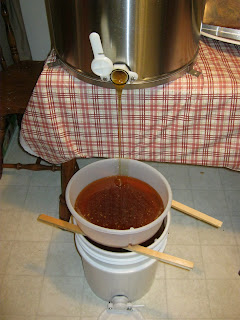Well, not really - it's a while until Old Man Winter arrives. But it is time to start getting the bees ready for winter.
In the wild, bees have a certain behavior when the days get shorter and the temperature starts dropping. They start to adjust their nest and move down, and any last bit of honey gets put up above them. The kick out the drones to die (since their usefulness has ended with the end of the summer), and the queen starts slowing down on her laying. But this preparation doesn't always allow the bees to survive the winter (for example, if they don't have enough food).
With managed hives, since we do rob them of some of the excess honey, we also try to help them get ready for winter. For me it's a matter of making sure they have enough food, and they have places they can store it.
This last weekend was a bit of Indian Summer, with temperatures in the high 70's / low 80's. The bees were out in force with the good weather (my wife has some Shasta Daisies growing in the back yard, the bees [including mason bees] are all over it). I decided it was a good time to do some winter preparations.
I needed to do the following:
- Take off the honey supers (since the bees haven't put anything up there)
- Check the top box to make sure they have room
- Put on an empty brood chamber above the inner cover, in preparation for adding jars of sugar syrup
I also dug out my storage bins in the garage that I use to put away some of the frames for the season. I got a surprise - I forgot that I had stuck in 3 full size frames which were pretty much full of sugar syrup "honey." They came from one of the Sutton hives which died last year. I put them there intending to put them on an active hive. Well, that will happen this weekend!
Brown Hive
I started with the brown hive. I started on the bottom box, and this was what I saw:
It's not a terribly large number of bees, but not too bad. I saw some bees bringing in pollen (probably from the daisies and something else which is bright orange). I marked them in the following picture:
There was also a good amount of pollen in the lower brood chamber:
Up top, the bees had collected some amount of nectar, but not enough for winter:
In the honey super I saw that the bees had some nectar stored, and about 1/3 of a frame of capped honey on two frames. These I will scrape open and set out for the bees to rob and put back into the hive.
Pink Hive
On the Pink Hive, I put the honey super (undrawn) on the brood chamber without a queen excluder. I didn't expect them to do anything with it, but it was worth a try. I was right - they didn't do anything with it.
But I did see the queen in this one:
Note that there isn't much brood - it looks like she's already cutting back on production.
Green Hive
The Green Hive got a pretty good makeover. You'll recall that this was a hive from a late summer nuc, so it hadn't really started going up into the top brood chamber (I added the top chamber a few weeks ago). I did see that they had started putting up some nectar there, so that's good.
I also had a Grey Nuc over at a friends house. It turns out that the queen in that nuc was really bad - she hardly had any brood production, even when it was in a nice environment away from other hives pestering it.
So I brought the gray nuc back, and let's say I left the queen there :-)
I decided to combine the bees from the grey nuc into the green hive to boost the number of bees. I did that.
Since the green hive had the least food, it got two of the frames of food from storage. Here is one of those frames:
So I have the hives ready for winter. I set out all of the supers a little way away from the hives so the bees can reclaim whatever nectar and honey is there.
Here are the three hives (the top box is an empty cover so I can easily add jars of syrup):
The empty box of the Grey Nuc is sitting off to the side so the bees that are left in there (there are always some) can go to their new home.
I'll mix up some 2:1 syrup to feed the bees at a later date.



















































